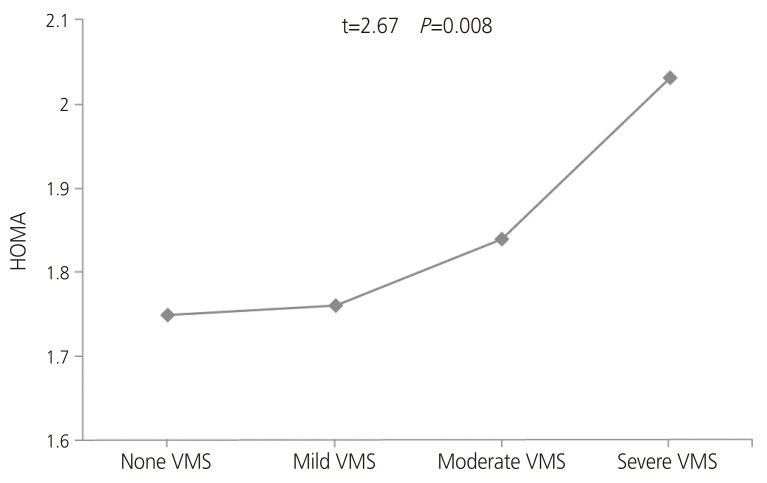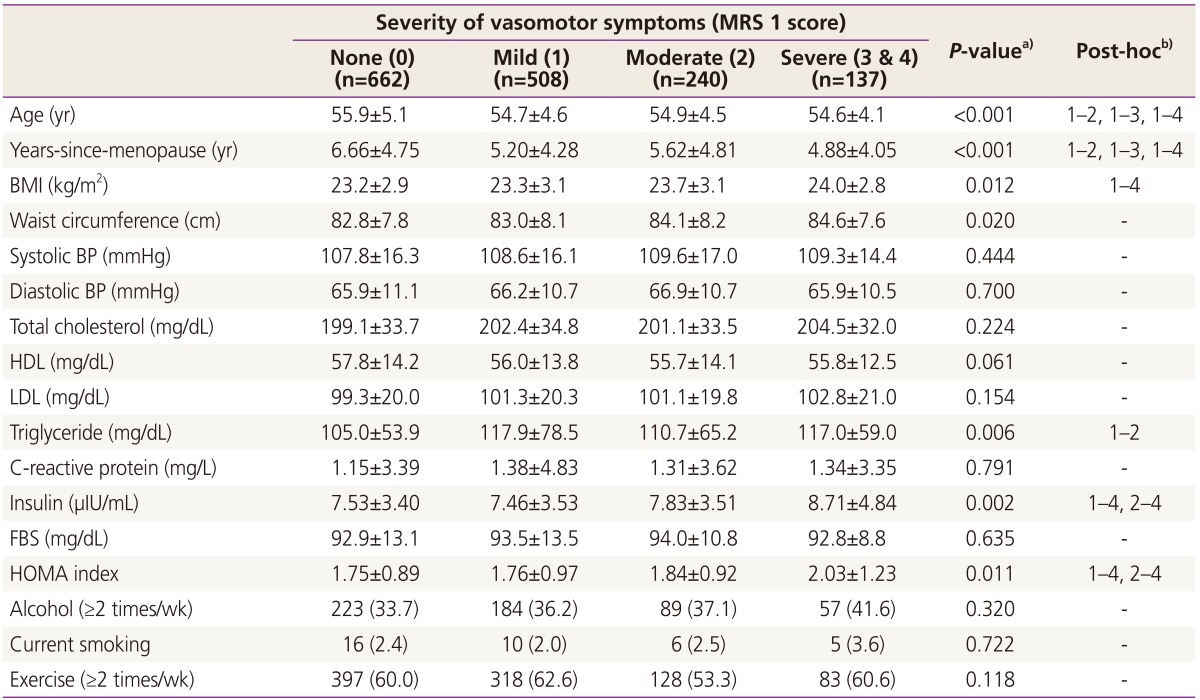1. Herber-Gast GC, Mishra GD, van der Schouw YT, Brown WJ, Dobson AJ. Risk factors for night sweats and hot flushes in midlife: results from a prospective cohort study. Menopause. 2013; 20:953–959. PMID:
23531688.
2. Hunter M. The south-east England longitudinal study of the climacteric and postmenopause. Maturitas. 1992; 14:117–126. PMID:
1565020.

3. Ryu KJ, Park HT, Kwon DH, Yang KS, Kim YJ, Yi KW, et al. Vasomotor symptoms and metabolic syndrome in Korean postmenopausal women. Menopause. 2015; 22:1239–1245. PMID:
25899005.

4. Thurston RC, Sowers MR, Sutton-Tyrrell K, Everson-Rose SA, Lewis TT, Edmundowicz D, et al. Abdominal adiposity and hot flashes among midlife women. Menopause. 2008; 15:429–434. PMID:
18204407.

5. Gast GC, Grobbee DE, Pop VJ, Keyzer JJ, Wijnands-van Gent CJ, Samsioe GN, et al. Menopausal complaints are associated with cardiovascular risk factors. Hypertension. 2008; 51:1492–1498. PMID:
18391100.

6. Gast GC, Samsioe GN, Grobbee DE, Nilsson PM, van der Schouw YT. Vasomotor symptoms, estradiol levels and cardiovascular risk profile in women. Maturitas. 2010; 66:285–290. PMID:
20400247.

7. Chedraui P, Hidalgo L, Chavez D, Morocho N, Alvarado M, Huc A. Menopausal symptoms and associated risk factors among postmenopausal women screened for the metabolic syndrome. Arch Gynecol Obstet. 2007; 275:161–168. PMID:
17021775.

8. Lee SW, Jo HH, Kim MR, Kwon DJ, You YO, Kim JH. Association between menopausal symptoms and metabolic syndrome in postmenopausal women. Arch Gynecol Obstet. 2012; 285:541–548. PMID:
21853251.

9. Thurston RC, El Khoudary SR, Sutton-Tyrrell K, Crandall CJ, Sternfeld B, Joffe H, et al. Vasomotor symptoms and insulin resistance in the study of women's health across the nation. J Clin Endocrinol Metab. 2012; 97:3487–3494. PMID:
22851488.

10. Hauser GA, Huber IC, Keller PJ, Lauritzen C, Schneider HP. Evaluation of climacteric symptoms (Menopause Rating Scale). Zentralbl Gynakol. 1994; 116:16–23. PMID:
8147175.
11. Matthews DR, Hosker JP, Rudenski AS, Naylor BA, Treacher DF, Turner RC. Homeostasis model assessment: insulin resistance and beta-cell function from fasting plasma glucose and insulin concentrations in man. Diabetologia. 1985; 28:412–419. PMID:
3899825.
12. Hou ZM, Sun Q, Liu YZ, Chen TF, Tang N. Effects of insulin resistance on myometrial growth. Int J Clin Exp Med. 2015; 8:1552–1557. PMID:
25785172.
13. Clapauch R, Mourao AF, Mecenas AS, Maranhao PA, Rossini A, Bouskela E. Endothelial function and insulin resistance in early postmenopausal women with cardiovascular risk factors: importance of ESR1 and NOS3 polymorphisms. PLoS One. 2014; 9:e103444. PMID:
25077953.

14. Lo JC, Zhao X, Scuteri A, Brockwell S, Sowers MR. The association of genetic polymorphisms in sex hormone biosynthesis and action with insulin sensitivity and diabetes mellitus in women at midlife. Am J Med. 2006; 119(9 Suppl 1):S69–S78. PMID:
16949391.

15. Burger HG, Dudley EC, Robertson DM, Dennerstein L. Hormonal changes in the menopause transition. Recent Prog Horm Res. 2002; 57:257–275. PMID:
12017547.

16. Eckel RH. The metabolic syndrome. In : Longo DL, Fauci AS, Kasper DL, Hauser SL, Jameson JL, Loscalzo J, editors. Harrison's principles of internal medicine. 18th ed. New York (NY): McGraw-Hill Companies;2012. p. 1992–1997.
17. Freedman RR. Pathophysiology and treatment of menopausal hot flashes. Semin Reprod Med. 2005; 23:117–125. PMID:
15852197.

18. Cagnacci A, Cannoletta M, Caretto S, Zanin R, Xholli A, Volpe A. Increased cortisol level: a possible link between climacteric symptoms and cardiovascular risk factors. Menopause. 2011; 18:273–278. PMID:
21037488.
19. Salpeter SR, Walsh JM, Ormiston TM, Greyber E, Buckley NS, Salpeter EE. Meta-analysis: effect of hormone-replacement therapy on components of the metabolic syndrome in postmenopausal women. Diabetes Obes Metab. 2006; 8:538–554. PMID:
16918589.

20. Semenkovich CF. Insulin resistance and atherosclerosis. J Clin Invest. 2006; 116:1813–1822. PMID:
16823479.







 PDF
PDF ePub
ePub Citation
Citation Print
Print



 XML Download
XML Download